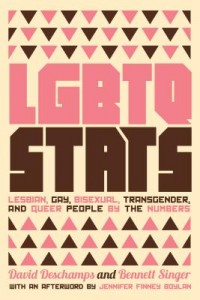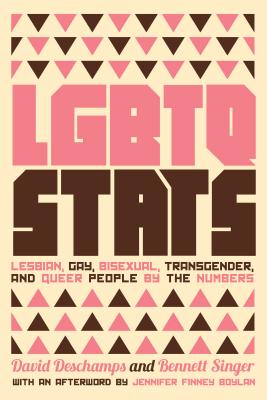 LGBTQ Stats: Lesbian, Gay, Bisexual, Transgender
LGBTQ Stats: Lesbian, Gay, Bisexual, Transgender
and Queer People by the Numbers
by David Deschamps and Bennett Singer
The New Press. 320 pages, $17.95
HOW MANY openly-LGBT rappers are there? What are the six states without any hate crimes laws? Which country leads the “gay happiness index”?
They may not have been questions you’ve thought of before, but the answers to these queries and about a thousand more are answered in LGBTQ Stats, a fascinating compilation of factoids and numbers culled from the research of authors David Deschamps and Bennett Singer.
To take one example: there was a lot of news about Russia’s 2013 ban on the promotion of homosexuality (or “non-traditional sexual relations”), which was passed unanimously by the country’s parliament. But there was little follow-up on when and how the measure was actually used in law. The founder of one online meeting place for queer youth was fined $750 after she was found guilty of spreading propaganda to promote such relations in 2015. Elena Klimova paid the fine, but argued that “even mentioning LGBT relations is essentially forbidden” under the law. The thought and organization that the authors have put into this book, a sequel of sorts to their 1994 stats compilation, takes it beyond a mere episode of Jeopardy.
The chapters often begin with a question that leads one to see how complicated statistics can be, at the best of times. The opener is about how many of us there are as a proportion of the whole population; and the answer has a lot to do with who’s asking the question and how it’s being posed. Deschamps and Singer cite over thirty studies and surveys, from Kinsey’s well-known estimate of ten percent in his 1948 study to an outlandish survey of Playboy readers that came in at 35 percent. More recent surveys involving larger samples and more rigorous methods seem to be converging on a figure of around four percent for the LGBT population.
As one digests the book, a narrative does develop beyond a mere parade of stats, and it is one of progress. Chronological data tell a story of progressive shifts in thinking on lgbtq issues, from greater acceptance of gay rights in general to acceptance and even an embrace of people across the alphabet spectrum, as well as those who are HIV-positive and pansexual. Many chapters include uplifting quotations from activists or community leaders who marvel at the seismic shifts in public thinking: “When you achieve something that you thought was fanciful much quicker than you imagined was possible,” National Center for Lesbian Rights executive director Kate Kendell says, “that tells you we’re on a really impressive arc.” While the main current is one of progress, the authors are careful to temper the optimism with glimpses into other parts of the world where lgbtq rights are often still nascent.
Given how far debates have come even since Bill Clinton’s presidency in the ’90s—when his effort to repeal the ban on gays in the military met with staunch resistance even from within the Democratic Party—there is certainly reason to be optimistic, as the authors clearly are. But I couldn’t help but be struck by the strange feeling that the book felt dated, as I was reading it during the first month of Trump’s presidency.
There were pauses in reading to see the news, which included the yanking of Breitbart.com’s gay mascot Milo from the line-up of speakers at the CPAC conference (after a recording surfaced of the self-styled iconoclast seeming to endorse inter-generational sexual relations) and Trump reversing the Obama Administration’s nationwide order that trans students be allowed to use the bathrooms of their choice. And that leaves LGBTQ Stats with an unintended—but impossible to ignore—aftertaste. “Twenty years ago,” the blurb on the back of the book enthuses, “it was impossible to imagine the president of the United States embracing same-sex marriage.” What a difference an election makes.
________________________________________________________
Matthew Hays, co-editor of the “Queer Film Classics” book series, is based in Montreal.






